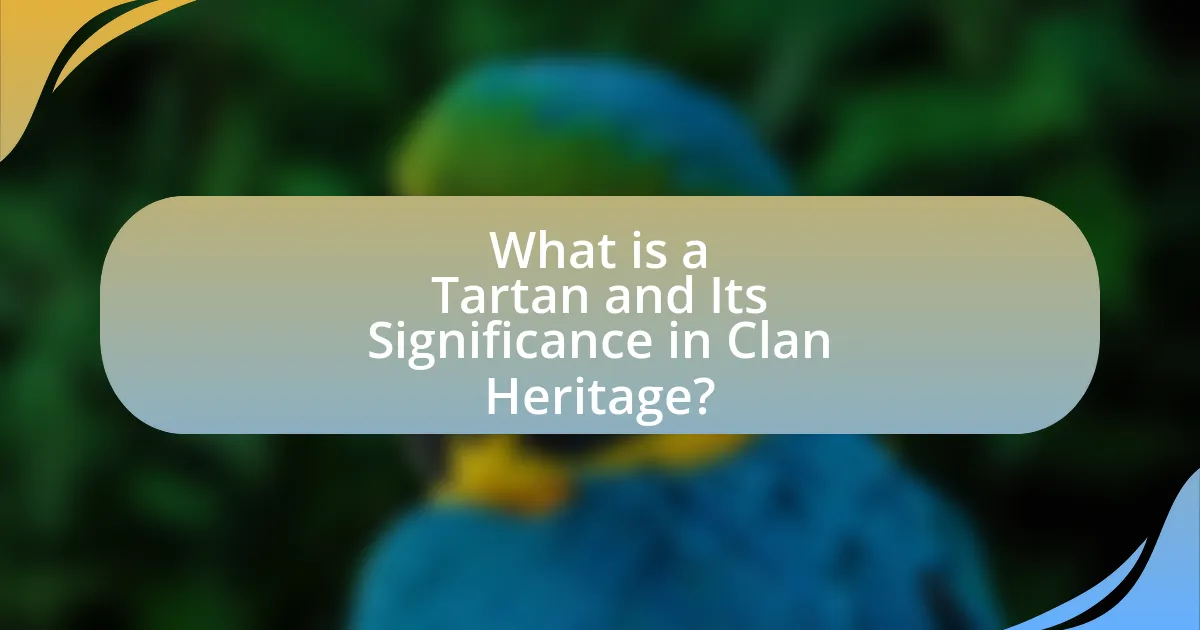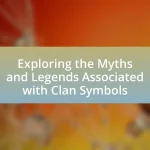The article focuses on the significance of tartan in representing clan heritage and identity within Scottish culture. It outlines the historical origins of tartan patterns, their connection to specific clans, and the importance of choosing the correct tartan to honor familial ties. The article also discusses the various types of tartans, including clan, district, and fashion tartans, and provides practical tips for identifying and selecting the right tartan based on personal preference, fabric quality, and authenticity. Additionally, it highlights resources available for discovering clan tartans and the role of clan societies in assisting with tartan identification.

What is a Tartan and Its Significance in Clan Heritage?
A tartan is a patterned fabric consisting of crisscrossed horizontal and vertical bands in multiple colors, traditionally associated with Scottish clans. The significance of tartan in clan heritage lies in its ability to represent specific clans or families, with each unique pattern serving as a symbol of identity and lineage. Historically, tartans were used to distinguish different clans, with the patterns often linked to specific regions or families in Scotland, such as the MacLeod or Campbell tartans. This connection to clan heritage fosters a sense of belonging and pride among members, as wearing a tartan signifies allegiance to one’s ancestry and cultural roots.
How is Tartan Connected to Scottish Clans?
Tartan is intricately connected to Scottish clans as it serves as a symbol of clan identity and heritage. Each clan has its own distinct tartan pattern, which historically represented the clan’s territory and lineage. The use of tartan dates back to the 16th century, with specific patterns being associated with particular clans, allowing members to visually identify themselves and their allegiance. This connection is further solidified by the Scottish Tartan Act of 1815, which formalized the association of specific tartans with clans, ensuring that these patterns became emblematic of Scottish culture and identity.
What are the Historical Origins of Tartan Patterns?
Tartan patterns originated in Scotland, with their earliest known use dating back to the 3rd century AD. Archaeological evidence suggests that the Celts used woven woolen cloth with distinctive patterns, which evolved into the tartans recognized today. The patterns were initially associated with specific regions and clans, serving as identifiers for Scottish families. By the 16th century, tartan became more standardized, with the establishment of specific patterns for various clans, solidified by the publication of the “Vestiarium Scoticum” in the 19th century, which documented clan tartans. This historical context illustrates the deep cultural significance of tartan patterns in Scottish heritage.
How Do Different Clans Use Tartan to Represent Their Identity?
Different clans use tartan patterns to represent their identity by associating specific designs with their unique heritage and history. Each clan’s tartan features distinct colors and patterns that symbolize their lineage, geographical origins, and cultural significance. For example, the MacLeod tartan is characterized by its bold yellow and black stripes, reflecting the clan’s historical ties to the Isle of Skye. Additionally, tartans serve as a visual marker of clan membership, fostering a sense of belonging and pride among members. The use of tartan in clothing, accessories, and ceremonial attire further reinforces clan identity, as seen in events like clan gatherings and Highland games, where individuals proudly display their specific tartan to signify their heritage.
Why is Choosing the Right Tartan Important?
Choosing the right tartan is important because it represents cultural identity and heritage. Each tartan pattern is associated with specific clans or regions in Scotland, and selecting the correct one honors familial ties and traditions. For example, the MacLeod tartan is distinct to the MacLeod clan, and wearing it signifies allegiance and connection to that lineage. Additionally, the right tartan can evoke a sense of pride and belonging, as it visually communicates one’s ancestry and cultural roots.
What Role Does Tartan Play in Clan Events and Ceremonies?
Tartan serves as a significant symbol of identity and heritage during clan events and ceremonies. It represents the unique lineage and history of a clan, often worn by members to showcase their affiliation and pride. For instance, specific tartan patterns are associated with particular clans, making them a visual representation of clan loyalty and unity. Historical records indicate that tartan has been used in Scottish culture for centuries, with its patterns often linked to specific regions and families, reinforcing the importance of tartan in maintaining clan traditions and fostering a sense of belonging among members during gatherings and celebrations.
How Can the Wrong Tartan Affect Clan Representation?
The wrong tartan can significantly misrepresent a clan’s heritage and identity. Tartan patterns are often closely associated with specific clans, and wearing an incorrect tartan can lead to confusion about one’s lineage and cultural affiliation. For instance, each tartan has unique historical and familial ties; wearing a tartan that does not belong to one’s clan can be seen as disrespectful or misleading. This misrepresentation can undermine the sense of belonging and pride within the clan, as tartans serve as symbols of unity and heritage. Historical records indicate that clans have distinct tartans that reflect their unique histories, and deviating from these can dilute the cultural significance attached to them.
How to Identify Your Clan’s Tartan?
To identify your clan’s tartan, start by researching your family lineage and the specific clan associated with your heritage. Each Scottish clan has a unique tartan pattern that represents its identity, often documented in clan registries or tartan databases. For example, the Scottish Tartans Authority maintains a comprehensive database that includes registered tartans linked to various clans. Additionally, you can consult books such as “Scottish Tartans: The Complete Guide” by John T. McGowan, which provides detailed descriptions and images of clan tartans. By cross-referencing your clan name with these resources, you can accurately identify the tartan that corresponds to your clan.
What Resources are Available for Finding Your Clan’s Tartan?
To find your clan’s tartan, several resources are available, including clan association websites, tartan registries, and specialized books on Scottish heritage. Clan association websites often provide detailed information about the specific tartans associated with each clan, including historical context and variations. Tartan registries, such as the Scottish Register of Tartans, offer a comprehensive database where individuals can search for their clan’s tartan by name or pattern. Additionally, books like “The Tartan Dictionary” by Philip D. Smith provide insights into the history and significance of various tartans, making them valuable resources for anyone researching their clan’s heritage.
How Can Clan Societies Assist in Tartan Identification?
Clan societies can assist in tartan identification by providing access to historical records and resources that detail specific tartans associated with particular clans. These societies often maintain archives of clan histories, which include information about the origins and variations of tartans. For example, the Scottish Tartans Authority offers a comprehensive database that catalogs registered tartans, allowing individuals to trace their lineage and find the corresponding tartan for their clan. Additionally, clan societies frequently host events and gatherings where members can share knowledge and expertise about tartan patterns, further aiding in accurate identification.
What Online Tools Can Help You Discover Your Clan’s Tartan?
Online tools that can help you discover your clan’s tartan include websites like the Scottish Register of Tartans, which provides a comprehensive database of registered tartans, and Clan Tartan Finder, which allows users to search for specific clan tartans by name. Additionally, resources such as Tartan Finder and Tartan Weaving provide visual references and historical context for various tartans. These platforms are reliable as they are maintained by organizations dedicated to preserving Scottish heritage and tartan history.
What are the Different Types of Tartans?
There are several types of tartans, primarily categorized into clan tartans, district tartans, and fashion tartans. Clan tartans represent specific Scottish clans and are often registered with the Scottish Tartans Authority, ensuring their authenticity and heritage. District tartans are associated with geographical areas rather than specific clans, reflecting regional pride. Fashion tartans, on the other hand, are created for commercial purposes and may not have historical significance. The existence of these categories is supported by the historical use of tartans in Scotland, where clan identity and regional affiliations were visually represented through distinct patterns.
What is the Difference Between Ancient, Modern, and Weathered Tartans?
Ancient, modern, and weathered tartans differ primarily in their color palettes and the historical context of their designs. Ancient tartans feature softer, muted colors that are inspired by the natural dyes used in the past, reflecting a more traditional aesthetic. Modern tartans, on the other hand, utilize brighter, more vivid colors that are created with synthetic dyes, catering to contemporary tastes. Weathered tartans present a faded appearance, simulating the look of a tartan that has been exposed to the elements over time, often incorporating both muted and vibrant colors to achieve this effect. These distinctions help individuals select a tartan that aligns with their clan heritage and personal preference.
How Do District and Regional Tartans Differ from Clan Tartans?
District and regional tartans differ from clan tartans primarily in their representation and purpose. Clan tartans are specifically associated with individual clans, reflecting their unique heritage and lineage, while district and regional tartans represent broader geographical areas or communities, encompassing multiple clans or families within that region. For example, the “Black Watch” tartan is a district tartan that symbolizes the Highland region, whereas the “MacDonald” tartan is specific to the MacDonald clan. This distinction highlights how clan tartans are tied to specific familial identities, whereas district and regional tartans serve to unify various clans under a common geographical or cultural banner.

What Factors Should You Consider When Choosing a Tartan?
When choosing a tartan, consider the clan affiliation, color patterns, and fabric type. Clan affiliation is crucial as specific tartans represent different clans, and selecting one associated with your heritage fosters a connection to your ancestry. Color patterns are significant as they convey various meanings and emotions; for instance, brighter colors may symbolize joy, while darker shades can represent solemnity. Additionally, the fabric type affects the tartan’s use; wool is traditional for warmth and durability, while lighter materials may be suitable for summer wear. These factors ensure that the tartan chosen is not only representative of heritage but also practical for intended use.
How Does Personal Preference Influence Tartan Selection?
Personal preference significantly influences tartan selection by guiding individuals in choosing patterns, colors, and styles that resonate with their personal identity and aesthetic tastes. This selection process is often shaped by factors such as cultural significance, family heritage, and emotional connections to specific colors or designs. For instance, individuals may prefer tartans that reflect their clan’s history or those that evoke personal memories, thereby enhancing their sense of belonging and pride. Additionally, studies indicate that color psychology plays a role in preference, as certain colors can evoke specific emotions and associations, further impacting the choice of tartan.
What Colors and Patterns Reflect Your Clan’s Heritage?
Colors and patterns that reflect a clan’s heritage often include specific shades and designs that are historically associated with that clan. For example, the MacLeod clan is represented by yellow and black, while the Campbell clan features blue and green. These colors are derived from the natural landscape and historical significance tied to the clan’s origins. Patterns, such as checks or stripes, are also distinctive; for instance, the tartan of the MacKenzie clan includes a specific arrangement of colors that symbolizes their lineage. The use of these colors and patterns is rooted in tradition, with many clans having unique tartans that have been passed down through generations, reinforcing their identity and heritage.
How Should You Consider Fabric and Quality in Your Choice?
When choosing tartan for your clan heritage, consider fabric type and quality as they significantly impact durability and appearance. High-quality fabrics, such as wool or a wool blend, offer better resilience and a traditional look, which is essential for authentic tartan. For instance, 100% wool tartans are known for their warmth and longevity, making them ideal for garments and accessories that will be used frequently. Additionally, the weight of the fabric, typically measured in ounces per yard, affects the drape and suitability for different uses; heavier weights are preferable for outerwear, while lighter weights are better for shirts or sashes. Therefore, selecting a high-quality fabric ensures that the tartan not only represents your clan heritage accurately but also stands the test of time.
What Practical Tips Can Help You Choose the Right Tartan?
To choose the right tartan, first identify your clan or family heritage, as many tartans are associated with specific clans. Research the historical significance and variations of the tartan linked to your clan, as this will ensure authenticity and respect for tradition. Additionally, consider the color palette and patterns that resonate with you personally, as tartans can vary widely in design. Finally, consult reputable sources or retailers specializing in tartan to verify the quality and accuracy of the fabric, ensuring it aligns with your clan’s heritage.
How Can You Ensure Your Tartan Choice is Authentic?
To ensure your tartan choice is authentic, verify its registration with the Scottish Register of Tartans, which maintains a comprehensive database of officially recognized tartans. Authentic tartans are often linked to specific clans or families, and you can confirm this connection through historical records or clan associations. Additionally, reputable suppliers will provide documentation or provenance for their tartans, ensuring they adhere to traditional patterns and colors. The Scottish Register of Tartans, established in 2008, serves as a reliable resource for confirming the authenticity of tartans, making it essential for anyone seeking genuine clan heritage representation.
What Should You Look for When Purchasing Tartan Products?
When purchasing tartan products, you should look for authenticity, quality of material, and the specific tartan pattern associated with your clan. Authenticity ensures that the tartan is made from genuine Scottish wool and adheres to traditional weaving methods, which is crucial for preserving cultural heritage. The quality of material, such as 100% wool or a wool blend, affects durability and comfort, with high-quality wool providing warmth and breathability. Additionally, selecting the correct tartan pattern is essential, as each pattern represents a specific clan or family lineage, making it significant for personal and cultural identity.





